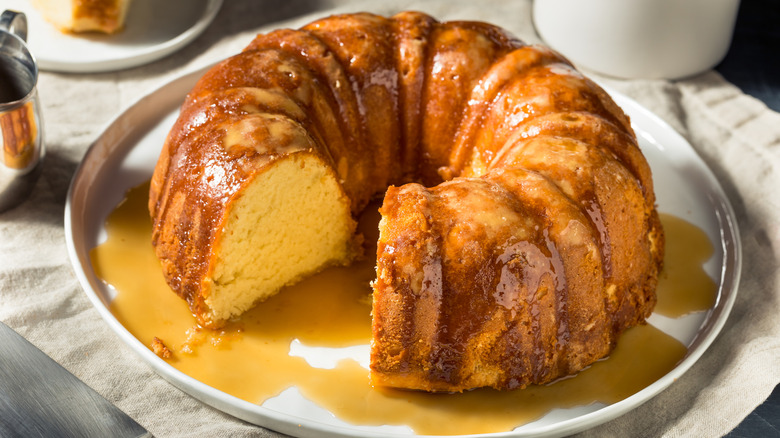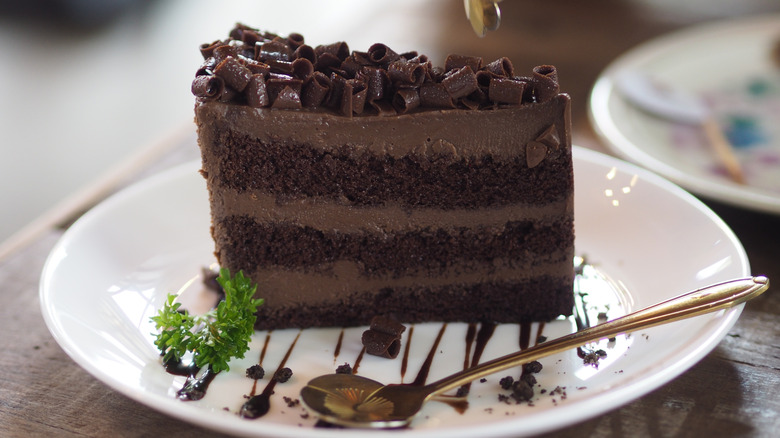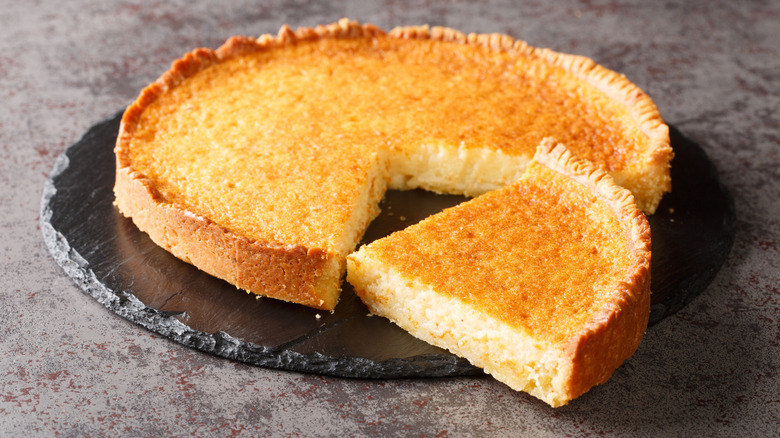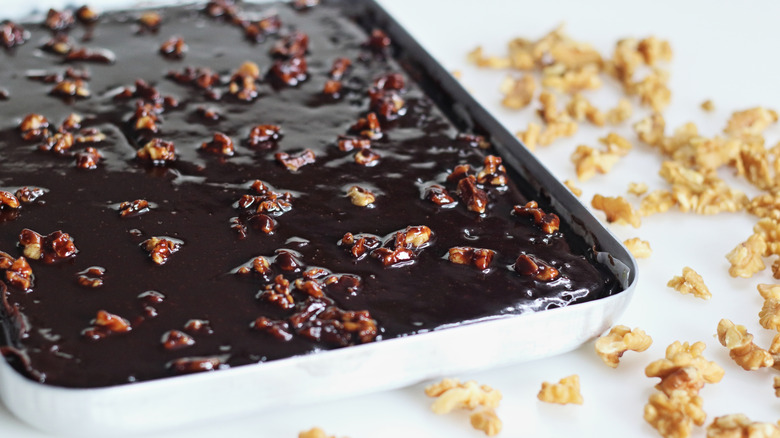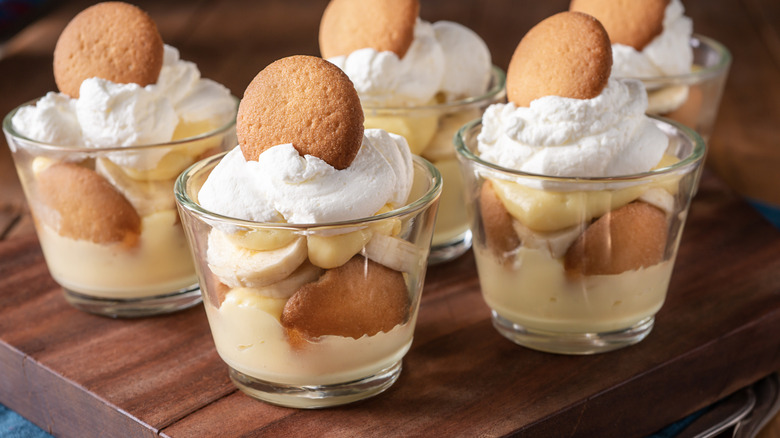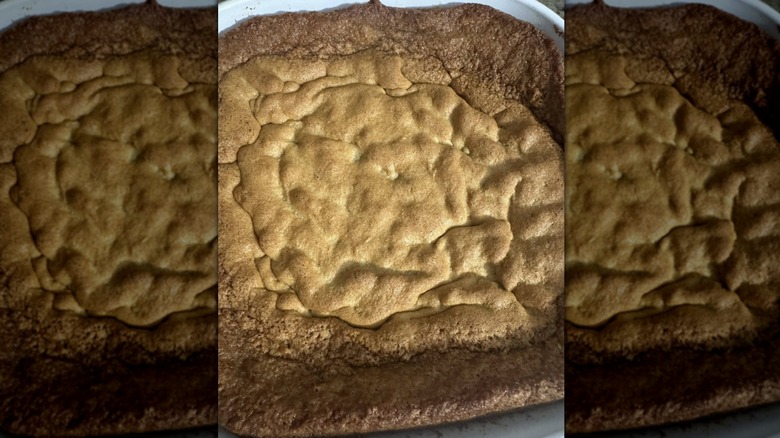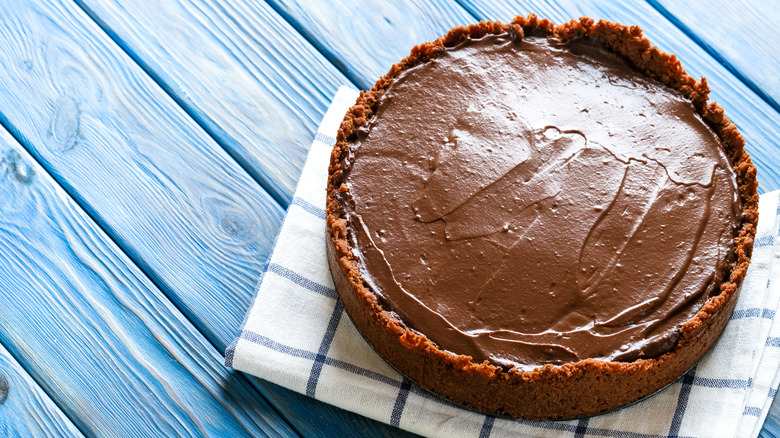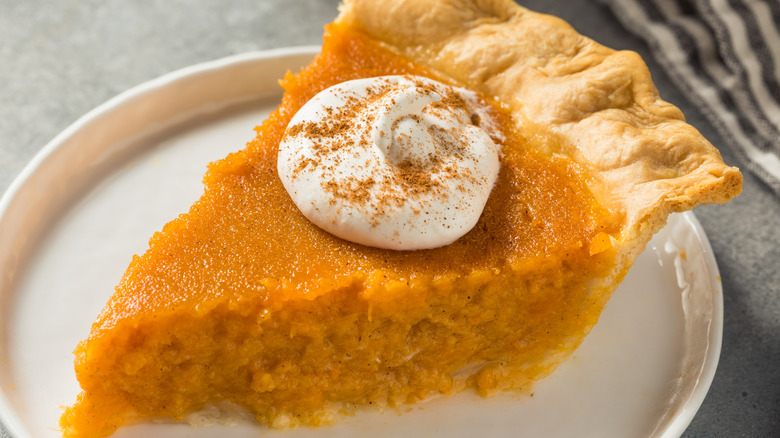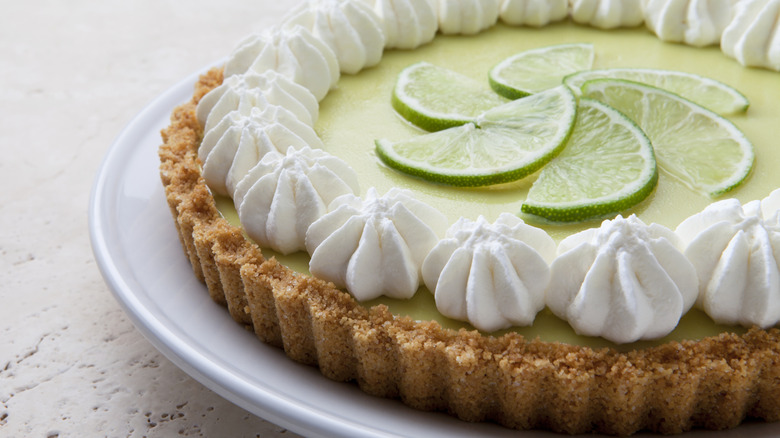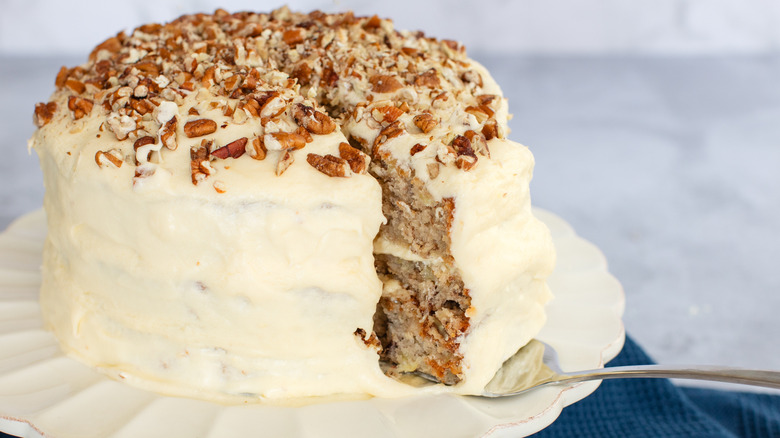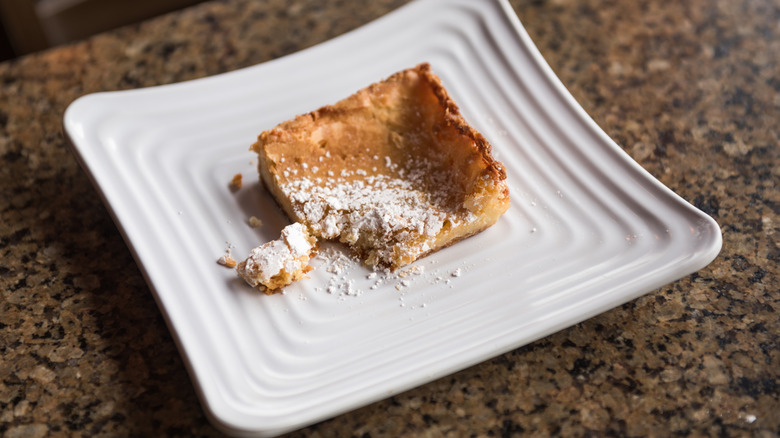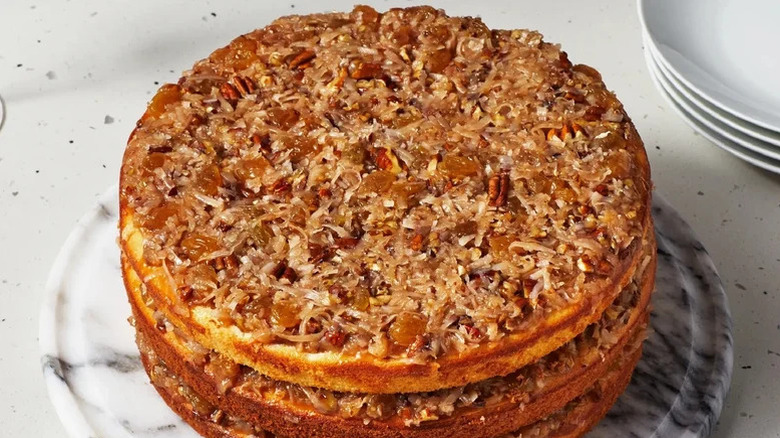Old-Fashioned Southern Desserts Ready For A Revival
What defines a desert as Southern? Does it have to be invented in the South? Does it have to be eaten in the South more often than anywhere else? It's actually tricky to say precisely what the criteria for Southern status is. Regardless, a lot of food and other traditions are widely regarded as being officially south of the Mason-Dixon line. It often has to do with what major Southern publications have released. If Southern Living, for instance, began printing recipes for a particular cake sometime in the early 20th century, then the cake can pick up a reputation as being distinctly Southern.
And if the mere mention of a given dessert evokes a "yum" from a Southerner and a confused head scratch from a Yankee, that's a kind of clue of its own. Let's take a look at some killer desserts you should not be surprised to find at your next Texas hoedown.
German chocolate cake
The most surprising thing about German chocolate cake is that it's not German at all. Its chief ingredient (German chocolate) was invented by a man named Samuel German. German was a chocolate mill worker, and he developed the famous chocolate that now bears his name. Originally, it was called "Baker's German Sweet Chocolate," and it contained more sugar than usual so that cooks didn't have to add extra chocolate when they baked. In the 1950s, this cake's recipe was featured in the Dallas Morning News, and it only gained popularity from there.
These days, German chocolate cake is something of a Southern staple, and it's famous for its rich coconut cream-frosted exterior. On this inside is that same, deeply sweet chocolate that has captured the attention of dessert lovers for the better part of a century. There are a few things to remember when baking your own version of this cake. For instance, don't skimp on the ingredient quality. Use high-quality versions of the ingredients to make sure this cake reaches its full potential — this is especially true of the chocolate, butter, and buttermilk. And be careful not to over-mix it, either. This can lead to the development of gluten, which will leave you with cake layers that are almost rubbery in texture. And if you really love German chocolate cake, turn it into a shot.
Peach cobbler
Warm, tangy peaches and buttery crust come together in the peach cobbler, a fruity pie that's practically synonymous with Southern treats. Peaches originated in China, but they were eventually brought to the American South where they found themselves quite at home in all that Southern heat. The popularity of peaches in this region can be seen in that famous Southern term of endearment "Southern peach." It was only a matter of time before Southerners turned this lovely fruit into the dessert it deserves.
In the pre-Civil War United States, cobblers were popular among enslaved cooks of the South. A cobbler is basically just a deep-dish fruit serving with a pie or biscuit crust topping — so called because the surface of the pie has that charming "cobbled" appearance, resembling the type of paved road made up of small round stones or "cobbles." Unlike stone, the exterior of a properly baked peach cobbler has just the right texture between soft and crunchy, giving way to the sweet gooey peach filling. The baking process can be fickle, though — when making peach cobbler, always divide and weigh ingredients with care to ensure the pie comes out just right.
Buttermilk pie
The humble, yet deeply satisfying buttermilk pie is an old-fashioned Southern confection that pairs incredibly well with whipped cream and a light dusting of nutmeg. The core trick to buttermilk pie is using buttermilk instead of whole milk. Other than that, it's incredibly easy to make (relative to other baked goods) due to the simplicity of its ingredients. You probably have most of them lying around your kitchen already. This ease of access made buttermilk pie quite popular during the Great Depression. Eggs, flour, lemon juice, vanilla extract, and a few other common ingredients come together in the making of this customary Southern treat. Buttermilk pie is famous for its "Goldilocks" quality: It doesn't lack sweetness, but nor is it overwhelmingly sweet. It's just right.
There's nothing quite like the feeling of biting into the flaky golden crust of a buttermilk pie, and this is doubly true if you made it yourself. And even though this pie is a classic, you can always throw in a little twist or two as you put it together. It pairs excellently with whipped topping or ice cream on the side. And after you grab yourself a slice, try a drizzle of caramel syrup for a beautiful, tasty final touch. Fresh berries are also a guilt-free way to diversify the flavors and bring a tart, fruity character to the whole presentation.
Texas sheet cake
Texas has claimed this sheet cake as its own masterpiece, and it's the gloomiest dessert imaginable. That's because it goes by another moniker of "Texas funeral cake." No one can say for sure where this cake got its start, but there is evidence that funeral cakes were an old European tradition before they showed up in the U.S. It's still a popular choice to provide cakes at funerals in rural Sweden, where the cake serves to refresh funeral attendees and act as a "token of remembrance." The American South has maintained its own version of this — known as the Texas sheet cake — presenting with a chocolate cake topped by pecans. It's actually fairly similar to the German chocolate cake.
It's also become a popular choice for church events in Texas, prompting another fun title: church lady cake. This moist chocolate beauty is often frosted using icing from milk, cocoa powder, vanilla, butter, and sugar. And the nutty crunch from the pecans brings it all together. Some folks reckon that it's truly a Texan tradition because of how its flat, wide form resembles the contours of Texas' actual landscape. Regardless of whether this is stretching it, the Texas funeral cake remains a down-home tribute to the South's sweet tooth.
Banana pudding
One of the earliest banana pudding recipes comes to us from Massachusetts in 1888 — specifically from a newspaper called Good Housekeeping, where it was listed as calling for a custard layer, ladyfingers, sponge cake, plus fruit and whipped topping. These were to be assembled in a glass serving dish that places each layer on display for drooling purposes. There were variations on this offering, some of which were less of a pudding and more of a gelatin. It wasn't until around 1920 that the modern banana pudding emerged, substituting sponge cake for vanilla wafers. About 20 years after that, it had reached a point where banana pudding was rarely seen without vanilla wafers.
Indeed, Nabisco has really capitalized on this association, and has often printed banana pudding recipes on the side of the box. So what's Southern about banana pudding? Well, aside from the fact that it is regarded as a Southern dessert, not much. There was a syndicated column in the 1930s that listed a "Southern Banana Pudding" recipe, but by the 1950s, publications were known to commonly mention the dessert's "Southern" roots. Today, banana pudding is often served in a glass dish so you can see those mouthwatering layers of alternating pudding and wafers, but however you make it, you can expect it to be a hit wherever it goes.
Southern chew bread
"Chew bread" sounds a little like something you'd give a dog, but don't let the name fool you — this chewy bread is a famous Southern dessert that spread widely across the Carolinas. The stuff is also known under its charming informal appellation, "Charleston chewies" — not to be confused with the old-fashioned nougat strip known as "Charleston Chew." The ingredients are simple: butter, flour, pecans, eggs, and vanilla. The results, however, are a complex intermingling of flavors that provide chew bread its famous reputation for sweet decadence. Often served as a church morning dessert, it is cut into delightfully compact squares of chocolatey goodness, which also makes it perfect for snacking on the go.
It may look like a brownie, but the process for a Charleston chewie is actually closer to that of making candy. The butter in chew bread enters into the baking process only after it is first melted and subsequently cooled, which leads to a richer, more robust bar. Weirdly enough, that bar is more like a blondie, which latter is a type of non-cocoa dessert bar cousin to the brownie. Though it's thought of as Southern, its origins are mysterious, and some conjecture places their development with sharecroppers in the old South.
Mississippi mud pie
One of the most decadent items on our list, this thing is like royalty among Southern desserts. The Mississippi mud pie consists of layer after layer of unbelievable sweetness. There's Oreo cookie crust, fudge/brownies, chocolate pudding, and whipped cream on top. As with many of these Southern baked goodies, the Mississippi mud pie comes from who knows where. There's some speculation that it was derived from Mississippi mud cake, a tray-baked dish of chocolate, marshmallow, butter, and nuts. But according to legend, a waitress birthed the title in 1927 when she discovered a melted chocolate pie and noted its similarity to the muddy banks of the mighty Mississippi River.
Wherever it comes from, this creamy dish is a chocolate masterpiece of cocoa crust, brownie, and pudding layered atop one another. To be fair, there are as many mud pie recipes as there are fish in the Mississippi. Some have only one layer or include ice cream, meringue, chocolate pudding, or fudge sauce. Some recipes go all in on the chocolate, using things like chocolate brownie, a chocolate glaze, and packing the whole thing in a chocolate cookie crust. Some recipes employ cream cheese frosting or serve it up with whipped topping and chocolate chips.
Sweet potato pie
Around the time of the Civil War, sweet potatoes were a common Southern crop. In the North, pumpkins were easier to come by. The result was something of a battle between pumpkin pie and sweet potato pie. It's hard to say which pie won out in the end, but everyone seems to have their preference. In 1881, a woman named Abby Fisher devised her own cookbook, which she had published with a recipe for sweet potato pie. Eventually, it became a staple among Black folks in the South.
Everyone seems to have their own long-standing family recipe passed down by ancestors. All recipes have in common is the sweet potato, of which this dessert requires approximately 1 pound. It's a popular autumn dessert that seems to garner attention come fall, and in some parts of the South especially, it's as important a tradition as pumpkin pie for Thanksgiving. Cinnamon, nutmeg, and vanilla are known to make an appearance in most sweet potato pies, bringing their sweetness to bear amidst the potent core of sweet potato. It's a perfect finale to a Southern meal of collard greens, cornbread, and — you guessed it — sweet potatoes.
Key lime pie
It turns out that authentic key limes can be tricky to come by, seeing as they come from tropical Southeast Asia. Regular limes will work just fine in a key lime pie, and chances are that you've only ever tried the regular lime kind anyhow. And while lime juice is available at your local grocery store, a series of fresh honest-to-goodness limes will lend the pie a more natural, balanced flavor. The lime is one of nature's most tart fruits, and it pairs so well with the creamy yogurt filling that it's hard to believe there was a time no one had invented this pie yet.
A few tips for your key lime pie, though: Instead of regular milk, try using sweetened condensed milk — the kind where the water is replaced with sugar. There are actually a number of different ways to make key lime pie, each with its own twist on the classic formula. But one of the best is where you add cinnamon while making the crust. It may seem odd, but this one spice can really bring some warm vibes to the whole thing. This is especially true if you're enjoying key lime pie over the holidays, where cinnamon can make just about any food feel holiday appropriate.
Hummingbird cake
Before representing Southern confections, the hummingbird cake was actually born in Jamaica. The Jamaican Tourist Board wanted to showcase the island's most popular fruits, several of which make an appearance in this cake, and so they distributed the recipe amongst newspapers, hoping to boost visitation. The exact reason why they named the cake after the hummingbird is a little vague, but the hummingbird is the national fowl of Jamaica, which lends the cake a sense of official Jamaican representation. Well, no complaints have been issued about this association so far because the cake is phenomenal.
This unconventional cake may surprise some dessert lovers who think they've tasted everything the world of cake has to offer. It's basically a banana cake with pineapple chunks and cream cheese frosting. What makes it Southern though? Well, in 1978, a recipe for this pecan-topped pastry appeared in Southern Living, and it basically caught like wildfire from there on out. Hummingbird cake can be stored in the fridge if you're saving it for an upcoming event, which works because it can be relied upon to retain its flavor for about five days while refrigerated. Rich, moist, and unique, some folks like to spice it up with cinnamon or nutmeg too. This is a dense, rich beast, and it belongs on summer picnic tables everywhere.
Gooey butter cake
Alright, so this one is technically a Midwest dessert, but Missouri, where the gooey butter cake was invented, contributed soldiers to both sides of the Civil War. Does that count? We hope so, because it's hard not to gush about this unique dessert. Hailing from St. Louis, this wonderful confection has a unique foundation that is both chewy and crispy; an unbelievably sweet filling; and a soft dusting of powdered sugar resting on top like a blanket of new snow in the morning dark.
Supposedly, this cake developed by accident. Sometime in the early-to-mid 1900s, a baker was trying to whip up a German coffeecake, but they added way too much butter. Instead of tossing the cake, they decided to sell it as is, and what do you know? It was a hit. One way or the other, this exceptional cake gained popularity in the South in particular for its luscious, buttery texture. Most of these cakes have two basic layers. On the bottom, you have a sweet yeasted cake, but the top is where the real magic happens. It's a mega-buttery batter that does not completely set when you bake it. The result is a creamy filling that feels something like pudding. Talk about moist.
Lane cake
A true down home Southern delicacy, this cake comes straight from Alabama where it was first tasted by the public at a baking competition. Initially, it was called "prize cake," which was an awfully lucky guess because it did indeed take home the blue ribbon. Lane cake is officially the state cake of Alabama, a well-earned title owing to its moist and ungodly-sweet layers. It achieved celebrity status when it was even included in Harper Lee's famous Southern gothic novel "To Kill a Mockingbird." In fact, it was also referenced by former president Jimmy Carter in his memoir, "Christmas in the Plains," as something his father would make every Christmas.
It's basically made up of white sponge cake with custard and dried fruit between each cake segment. The whole thing is soaked in bourbon and glazed with swirly white frosting. Some prefer a coconut pecan frosting over the white, though, which enhances the overall fruitiness of every bite. And if you're hung up on the mention of bourbon, you read it right — this is a grown-up cake with alcohol. The alcohol here is not just for flavor, either. It's active, so be careful how much you consume in one sitting.

